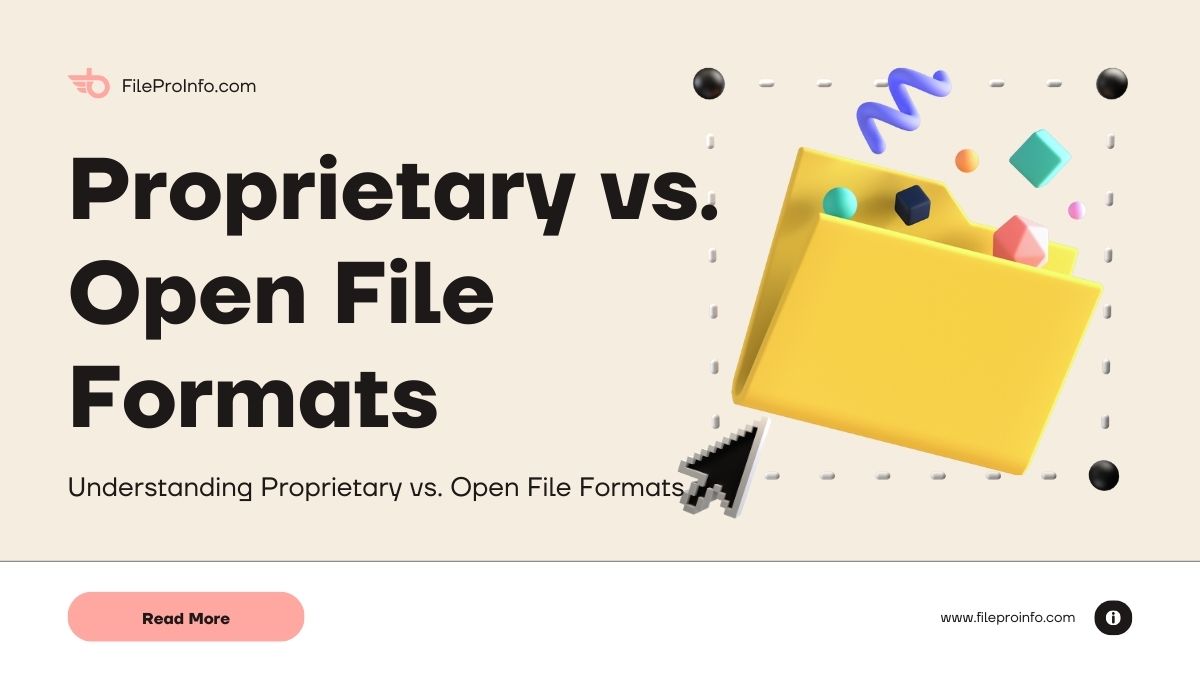
File formats impact today’s digital world. They significantly affect how we create, share, and store information. Two major categories dominate the landscape: proprietary and open file formats. Understanding the differences between these formats is key. Knowing their benefits and drawbacks can help users. It will help them make the best choices for their needs.
What Are File Formats?
A file format is a standard way of encoding information for storage in a computer file. It describes how bits are used to encode information in a digital storage medium. Text documents, images, audio, and video each need a different file format. Executable programs need one too.
Proprietary File Formats
A company or organization creates and controls proprietary file formats. These formats are used often. They ensure compatibility with software or hardware offered by the company. For example, Microsoft has the DOCX format for Word documents. Adobe has the PSD format for Photoshop files.
Characteristics of Proprietary Formats
- Ownership and Control: The format is owned by a company, which has control over its specifications and usage.
- Compatibility: Often designed to work seamlessly with the company’s own software and hardware.
- Licensing: Use of the format might require purchasing a license or using the company’s product.
- Innovation: Companies can innovate and enhance their formats rapidly since they control the development process.
- Support: Typically comes with dedicated customer support and regular updates from the owning company.
Advantages of Proprietary Formats
- Reliability: Often highly reliable within the ecosystem of the owning company’s products.
- Performance: Optimized for performance with the specific software and hardware.
- Security: Proprietary formats can include robust security features, controlled by the owning company.
Disadvantages of Proprietary Formats
- Vendor Lock-In: Users may be locked into using a specific company’s software or services.
- Cost: Often associated with higher costs due to licensing fees.
- Limited Interoperability: May not work well with other software or systems outside the proprietary ecosystem.
- Lack of Transparency: Users cannot see the underlying code or structure of the format, which can lead to issues with data accessibility over time.
Open File Formats
Open file formats are intended to be publicly accessible and usable by anyone without restriction. These formats are frequently created and maintained through collaborative efforts and standardization organizations. Examples include PDF documents and PNG images.
Characteristics of Open Formats
- Accessibility: Specifications are publicly available and can be used without restriction.
- Interoperability: Designed to be compatible with a wide range of software and hardware.
- Community Development: Often developed and maintained by a community of developers and users.
- Transparency: The format’s structure is open, allowing anyone to understand and implement it.
- Flexibility: Can be used and adapted in various contexts without proprietary constraints.
Advantages of Open Formats
- Freedom: Users are not tied to any single vendor or product.
- Cost-Effective: Typically free to use, reducing overall costs.
- Interoperability: Easier to share and use across different systems and platforms.
- Longevity: Open formats are often more sustainable over the long term due to broad adoption and support.
- Transparency: Users can inspect and understand the format’s structure, ensuring long-term data accessibility.
Disadvantages of Open Formats
- Support: May lack dedicated support and regular updates compared to proprietary formats.
- Consistency: Can be inconsistencies in implementation across different software products.
- Security: Open formats might not have the same level of built-in security features as proprietary formats.
Comparing Proprietary and Open File Formats
Use Cases
- Proprietary Formats: Ideal for environments where specific software and hardware integration is crucial. For example, a graphic design studio may rely on Adobe Photoshop (PSD) files for advanced image editing.
- Open Formats: Best for scenarios where data sharing and long-term accessibility are essential. For instance, using PDF for documents ensures that files can be opened and viewed across different platforms and devices.
Compatibility
- Proprietary Formats: While they offer excellent compatibility within the owning company’s ecosystem, they may pose challenges when used outside it. For example, a DOCX file created in Microsoft Word might not display correctly in other word processors.
- Open Formats: Generally provide broader compatibility, making it easier to share and use files across different systems. An example is the PNG image format, which is widely supported by various image viewers and editors.
Innovation and Development
- Proprietary Formats: Companies can rapidly innovate and update their formats, often adding new features and improving performance. However, this can also lead to frequent changes that may not be backward compatible.
- Open Formats: Innovation can be slower due to the collaborative nature of development, but the resulting formats tend to be stable and backward compatible. The development of open formats often focuses on broad usability and interoperability.
Security and Privacy
- Proprietary Formats: Often come with robust security features designed to protect data within the company’s ecosystem. However, this security can come at the cost of transparency.
- Open Formats: The transparency of open formats allows for independent security audits, but the lack of proprietary control can mean less rigorous security measures by default.
Proprietary Formats: Often come with robust security features designed to protect data within the company’s ecosystem. However, this security can come at the cost of transparency.
Open Formats: The transparency of open formats allows for independent security audits, but the lack of proprietary control can mean less rigorous security measures by default.
Choosing the Right Format
The choice is between proprietary and open file formats. It depends on many factors. These include the user’s needs. Also, the files’ intended use. And the need for interoperability versus performance.
- Assess Your Needs: Consider what you need the file for, how it will be used, and who will need access to it.
- Consider Compatibility: Think about the software and hardware that will be used to create, edit, and view the file.
- Evaluate Costs: Factor in any potential costs associated with licensing proprietary formats.
- Think Long-Term: Consider the long-term accessibility of your files. Open formats are often better for ensuring data remains accessible in the future.
- Security Requirements: Evaluate whether the security features of a proprietary format are necessary for your use case, or if the transparency of an open format is more beneficial.
Conclusion
Understanding the differences between proprietary and open file formats is vital. It is critical for making wise decisions about how to create, share, and store digital data. Both formats have pros and cons. The best option depends on the person’s needs and situation. Users can choose the best file formats for their needs. They can do this by carefully considering compatibility, cost, long-term access, and security.




